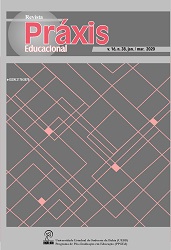MODELANDO LA CONSTRUCCIÓN DE LA PREVENCIÓN DEL AGOTAMIENTO: EL CASO DE LAS PERCEPCIONES DE LOS SUPERVISORES
DOI:
https://doi.org/10.22481/praxisedu.v16i38.6017Palabras clave:
Burnout, prevención de burnout, fuentes de prevención de burnout, construcción de prevención de burnoutResumen
La sobrecarga de trabajo de los docentes puede ocasionar desafíos para los docentes que provoquen agotamiento a largo plazo si no se abordan. En consecuencia, el presente estudio tiene como objetivo examinar las fuentes de prevención del agotamiento desde las perspectivas de los supervisores EFL (inglés como lengua extranjera). Los participantes fueron 85 supervisores de EFL iraníes cuyo trabajo consistía en observar y dar retroalimentación a los maestros sobre su desempeño docente en varios niveles de dominio del idioma, desde los niveles de primaria hasta los avanzados. En este estudio se empleó un diseño secuencial de método mixto. Primero, la recopilación de datos cualitativos se realizó mediante entrevistas con 30 participantes para determinar las fuentes de prevención del agotamiento desde la perspectiva de los supervisores. A continuación, se diseñó un cuestionario de prevención de agotamiento utilizando los resultados de las entrevistas, después de lo cual se administró a los participantes restantes. Los datos recopilados fueron analizados por factores para identificar los componentes de la construcción de prevención de agotamiento. Los resultados del análisis de contenido de los datos de la entrevista indicaron que el apoyo de los maestros por parte de sus colegas, la situación menos estresante y la satisfacción laboral fueron las principales fuentes de prevención del agotamiento. El análisis factorial mostró las mismas fuentes de agotamiento que los componentes principales de la construcción de prevención de agotamiento. Los hallazgos de este estudio enfatizan la contribución del apoyo educativo y emocional de los maestros, proporcionando un lugar de trabajo constructivo y saludable, así como ingresos deseables como formas de prevención del agotamiento en los maestros de EFL.
Descargas
Métricas
Citas
Bastas, M. (2016). Development of the teacher’s burnout scale. Anthropologist, 23(1, 2), 105-114.
Belias, D., & Koustelios, A. (2014). Leaderrship and job satisfaction - A review. European Scientific Journal, 10(8), 24-46.
Buonomo, I., Fatigante, M., & Fiorilli, C. (2017). Teachers' burnout profile: Risk and protective factors. The Open Psychology Journal, 10, 190-201.
Clandinin, D. J. (2014). Narrative conceptions of knowledge: Towards understanding teacher attrition. Bingley, United Kingdom: Emerald Group Publishing Limited.
Edmonson, S. (2006). Role ambiguity. In F. W. English, Encyclopedia of educational leadership and administration (Vols. 1-2). Thousand Oaks, CA: SAGE Publications, Inc.
Heidari, S., & Gorjian, B. (2017). The effect of the level of English teachers' burnout on the EFL learners' general English achievement at senior high school. Journal of Applied Linguistics and Language Learning, 3(2), 41-47.
Fernet, C., Guay, F., Senecal, C. B., & Austin, S. L. (2012). Predicting intraindividual changes in teacher burnout: The role of perceived school environment and motivational factors. Teaching and Teacher Education. An International Journal of Research and Studies, 28(4), 514-525.
Friedman, I. A. (1995). Measuring school principal-experienced burnout. Educational and Psychological Measurement, 55(4), 641-651.
Ghanizadeh, F., & Jahedizadeh, S. (2016). EFL teachers’ teaching style, creativity, and burnout: A path analysis approach. Cogent Education, 3, 1-17.
Gruenert, S., & Whitaker, T. (2015). School culture rewired: How to define, assess, and transform it. Alexandria, VA: Association for Supervision and Curriculum Development.
Jacobson, T. (2016). Entanglement equilibrium and the Einstein equation. Physical review letters, 116(20), 201101.
Khajavy, G. H., Ghonsooly, B., & Fatemi, A. H. (2017). Testing a burnout model based on affective-motivational factors among EFL teachers. Current Psychology, 36(2), 339-349.
Kuntz, J. R. C., Näswall, K., & Bockett, A. (2013). Keep calm and carry on? An investigation of teacher burnout in a post-disaster context. New Zealand Journal of Psychology, 42(1), 83-97.
Leiter, M. P., & Maslach, C. (2011). Banishing burnout: Six strategies for improving your relationship with work. Hoboken, NJ: John Wiley & Son’s Publishing.
Maroofi, S., & Ghaemi, H. (2016). On the relationship between EFL teachers’ on the relationship between EFL teachers’ burnout and their affective construct burnout and their affective construct. Journal of Studies in Learning and Teaching English, 5(2), 55-88.
Marzano, R. J., & Heflebower, T. (2012). Teaching and assessing 21st century skills. Bloomington, IN: Marzano Research Laboratory.
Maslach, C. (1993). Burnout: A multi-dimensional perspective. In W. B. Schaufeli, C. Maslach & T. Marek (Eds.), Professional burnout: Recent developments in theory and research (pp. 19–32). Washington, DC: Taylor and Francis.
Maslach, C., Schaufeli, W. B., & Leiter, M. P. (2001). Job burnout. Annual Review of Psychology, 52, 397-422.
Paula, B., & Antonino, C. (2011). Teachers’ burnout: A comparison between lay and consecrated teachers. International Journal of Developmental and Educational Psychology, 1(3), 1-13.
Rashtchi, M. & Mashhoor, H. S. (2019). Extravert and Introvert EFL Teachers: How do Reflective Teaching and Burnout Relate? Journal of Applied Linguistics and Language Research, 6(3), 73-88.
Roohani, A. & Dayeri, K. (2019). On the Relationship between Iranian EFL Teachers’ Burnout and Motivation: A Mixed Methods Study. Iranian Journal of Language Teaching Research 7(1), 77-99.
Rostami, S., & Ghanizadeh, A. (2015). A study of contextual precursors of burnout among EFL teachers. International Journal of Research Studies in Psychology, 4.
Sadeghi, A. (2016). Surveying the relationship between personality traits and self-esteem with job satisfaction. Psychology, 7(05), 655.
Schmidt, R., Boraie, D., & Kassabgy, O. (1996). Foreign language motivation: Internal structure and external connections. University of Hawai'i Working Papers in English as a Second Language 14(2).
Shamsafrouz, H., & Haghverdi, H. (2015). The effect of burnout on teaching performance of male and female EFL teachers in L2 context. International Journal of Foreign Language Teaching & Research, 3(11), 47-59.
Steiner, K. D. (2017). A qualitative analysis of primary school teachers’ burnout patterns. The New Educational Review, 179-189.
Zarafshan, H., Mohammadi, M. R., Ahmadi, F., & Arsalani, A. (2013). Job burnout among Iranian elementary school teachers of students with autism: A comparative study. Iranian journal of psychiatry, 8(1), 20-28.
Descargas
Publicado
Cómo citar
Número
Sección
Licencia
Usted es libre de:
Compartir — copiar y redistribuir el material en cualquier medio o formato; Adaptar — remezclar, transformar y construir a partir del material para cualquier propósito, incluso comercialmente. Esta licencia es aceptable para Obras Culturales Libres. La licenciante no puede revocar estas libertades en tanto usted siga los términos de la licencia.
Bajo los siguientes términos:
Atribución — Usted debe dar crédito de manera adecuada, brindar un enlace a la licencia, e indicar si se han realizado cambios. Puede hacerlo en cualquier forma razonable, pero no de forma tal que sugiera que usted o su uso tienen el apoyo de la licenciante.
No hay restricciones adicionales — No puede aplicar términos legales ni medidas tecnológicas que restrinjan legalmente a otras a hacer cualquier uso permitido por la licencia.










